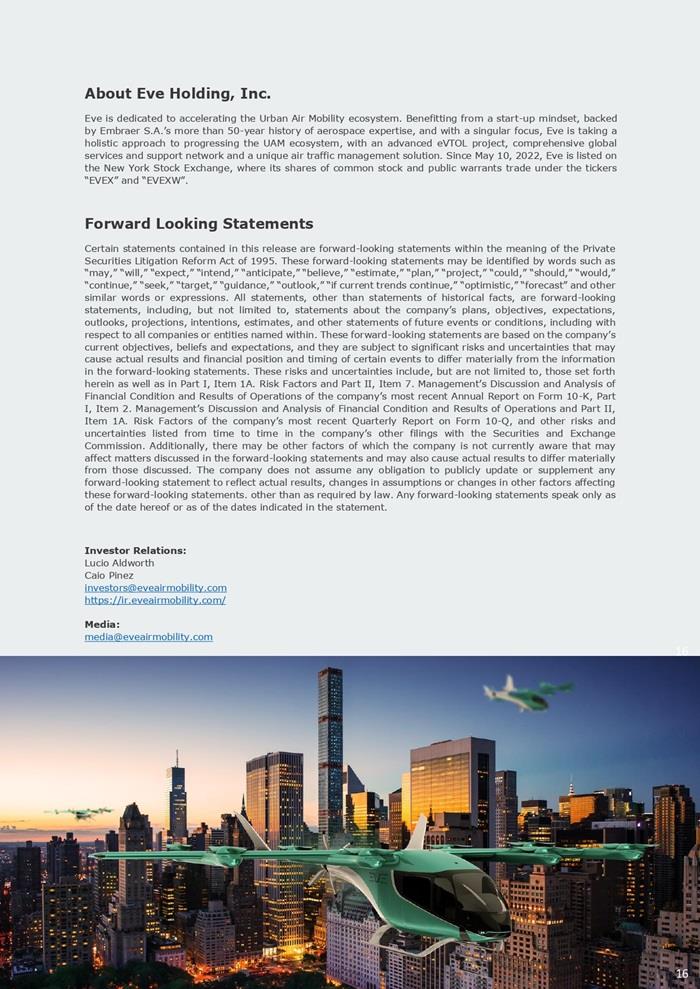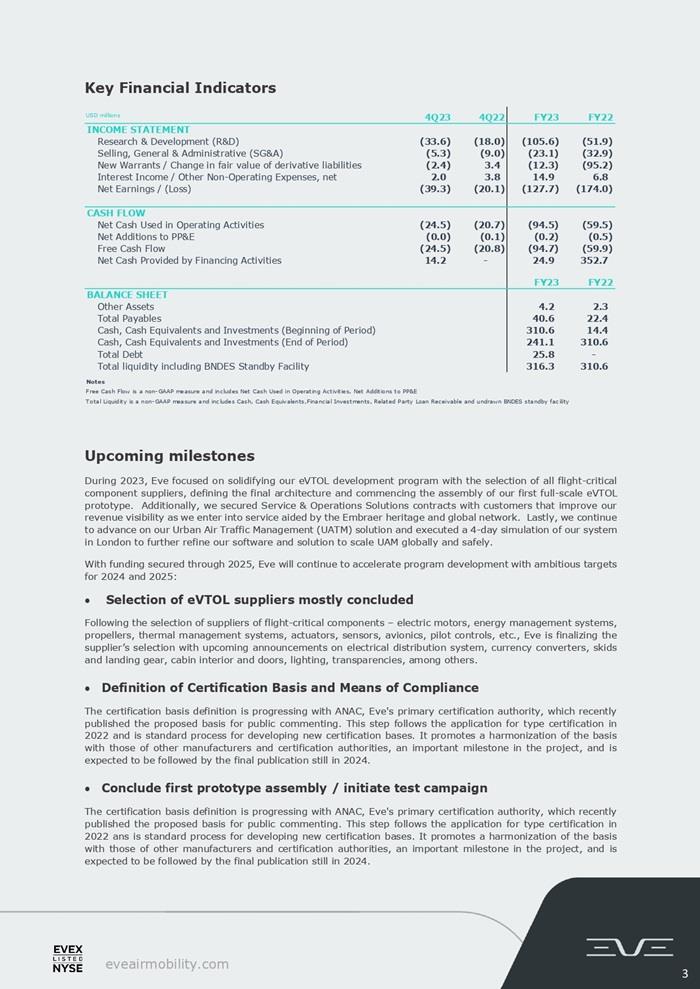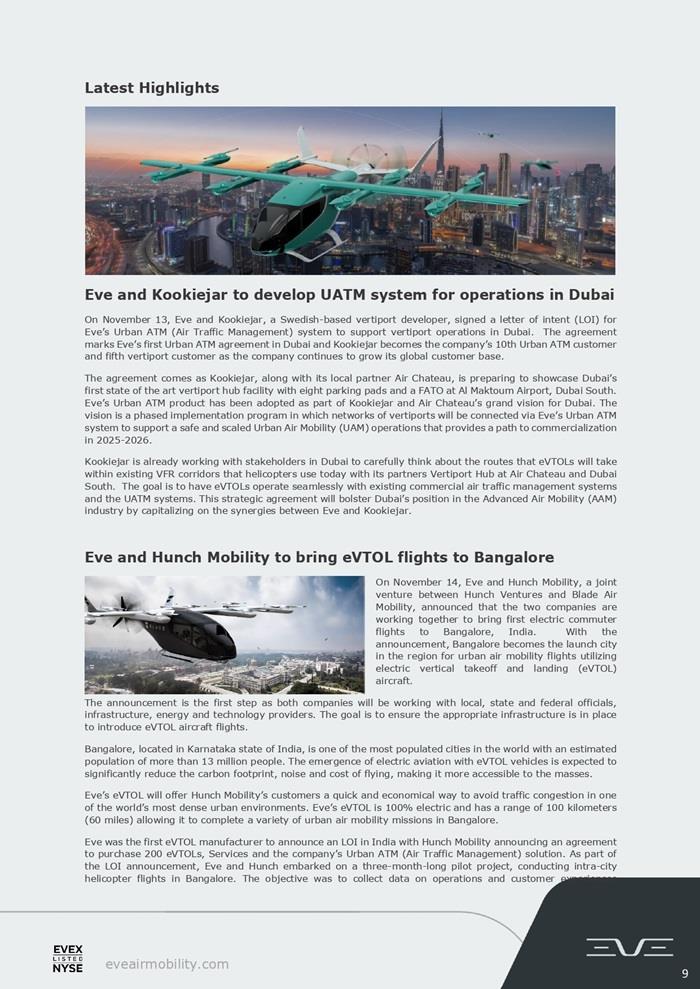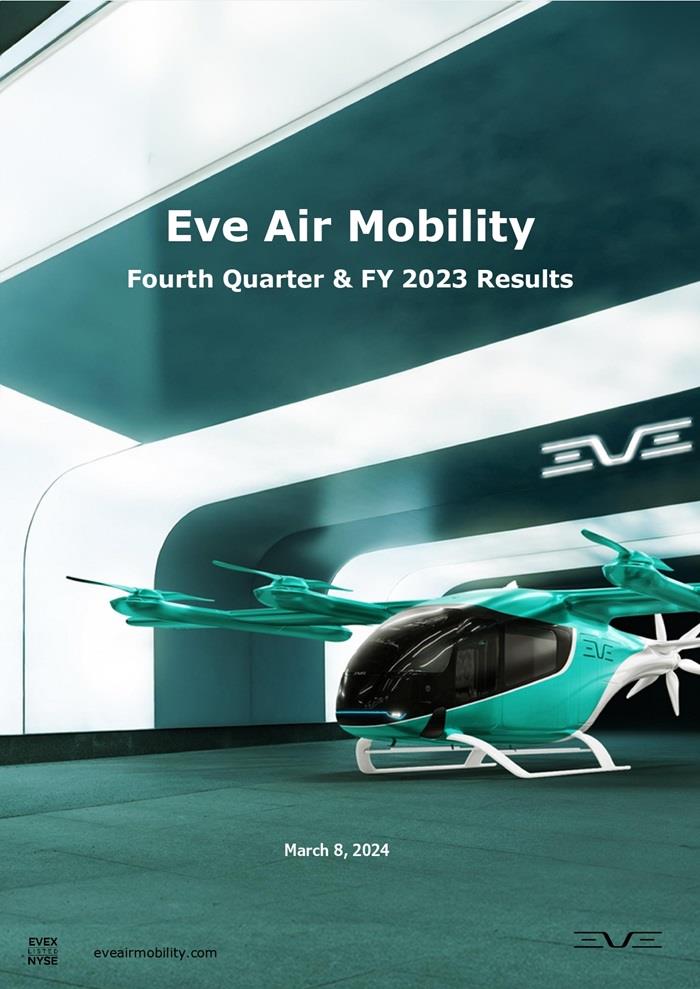
Eve Holding, Inc. Fourth Quarter & FY2023 Year in review Eve Air Mobility accomplished several milestones on our journey to shape the global Urban Air Mobility (UAM) ecosystem in 2023. With suppliers of flight-critical components selected for our eVTOL, we defined its final architecture. The DNA of our aircraft remains unchanged with a Lift + Cruise configuration – eight dedicated propellers for vertical take-off and landing, with no change in its position during flight and fixed wings to fly in cruise mode. Our eVTOL also includes a dual electric-motor pusher for horizontal propulsion redundancy with high performance and safety in mind. We believe our design offers numerous advantages such as fewer and simpler parts favoring reduced maintenance and operating costs, optimized structures and systems, and was conceived for efficient thrust and low sound emissions. With suppliers selected and final configuration defined, we initiated the production of our first full-scale prototype – to be used in our test campaign beginning in the latter part of 2024, when we will also initiate the assembly of up to five additional prototypes for the complete certification campaign. In mid-2023 we announced our first production facility in Brazil, located in the city of Taubaté – SP, close to Embraer’s engineering and support teams, and in the second semester of last year, we initiated the Joint-Definition Phase (JDP) of our development program. This is a crucial milestone in our eVTOL project timeline. It is during this phase that our technical team engages with their counterparts at our suppliers to perform a comprehensive analysis to ensure all the system interfaces are fully defined and the aircraft components will operate flawlessly with each other. This phase is critical to align and guarantee that the mechanical and software interfaces of the multiple components and subsystems, from different suppliers, will work seamlessly amongst each other and within the specifications of our eVTOL design and performance characteristics. Our team continues to test our eVTOL design and refine computer models in wind tunnels. The latest tests performed in Switzerland with powered rotors for the first time helping to calibrate the wing and rotors’ interface models, to improve aerodynamics. These improve performance of the cruise and transition phases of the flight. Eve leverages Embraer’s proven aircraft development practices, testing subsystems separately through various methodologies to validate Proofs of Concept (POCs) and advance towards full-scale prototype of our commercial vehicle for the certification process. Our agile, model-based approach allows us to validate components and airframe features independently in a quick and efficient manner. The goal is to develop safe, reliable, and affordable eVTOL solutions, which we believe will be achieved through our design configuration. We have initiated the certification process of our eVTOL with Brazil’s aviation authority – National Civil Aviation Agency of Brazil (ANAC), and we expect the validation process for the Type Certification (TC) in Brazil to be followed by the FAA (U.S. Federal Aviation Authority) targeting a dual certification and entry into service in 2026. We are also in discussions with the European Union Aviation Safety Agency (EASA) and other certification authorities. We believe undivided attention from ANAC combined with our expertise in certification and the simple design of our aircraft puts Eve on a clear path to global acceptance. The result of Eve’s strengths is the largest and most diversified backlog (by number of customers and regions) in the industry today. In total, we have non-binding LOIs (Letter of Intent) for 2,850 aircraft, from 29 different customers spread over 13 countries and different markets. This, combined with Service & Operations Solutions contracts offers strong long-term revenue visibility and will help Eve to smooth cash-flow consumption in the years to come as we start to convert the existing LOIs into firm orders and collect pre-delivery payments (PDP). Concurrently, Eve continues to develop a unique Urban Air Traffic Management (Urban ATM) software to optimize and scale Urban Air Mobility operations worldwide safely. The company has already secured 14 customers for the software. With current total liquidity in excess of $300 million, we feel comfortable that our financial position is sufficient to fund our Research & Development (R&D) requirements as well as operations through 2025. We believe Eve has the right partners, experience, and development team to support the foundation for success in the design, certification, assembly and support of eVTOLs and the UAM market in the years ahead. Johann Bordais CEO
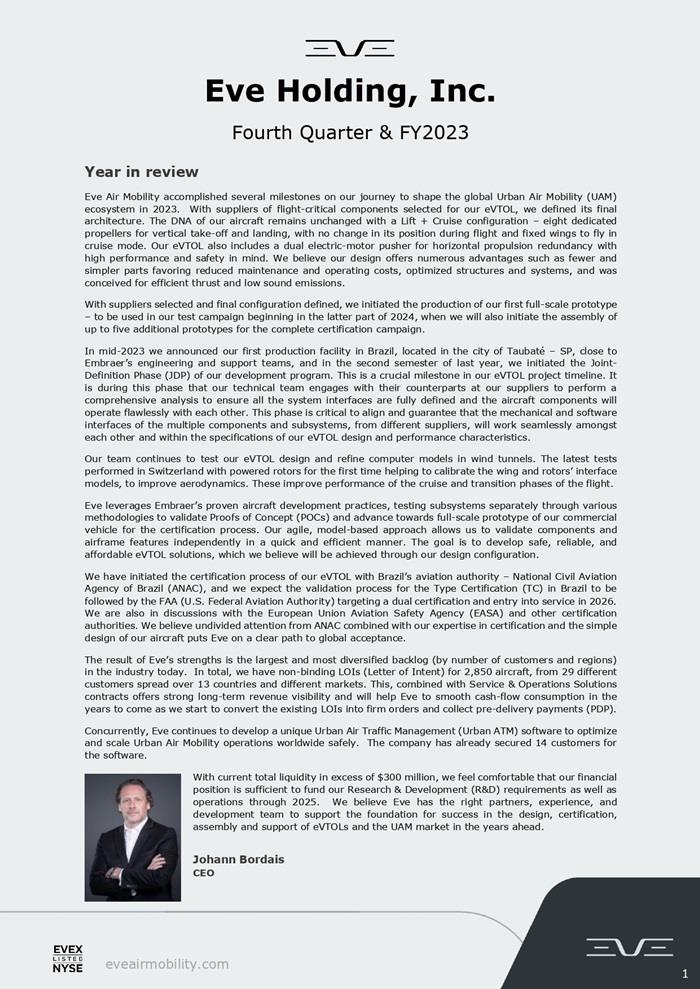
Financial highlights
Eve Air Mobility is an aerospace company dedicated to the development of an eVTOL (electric Vertical Takeoff and Landing) aircraft and the Urban Air Mobility (UAM) ecosystem that includes the aircraft development, Service & Operations Solutions and an Urban Air Traffic Management (Urban ATM) system. Eve is pre-revenue; we do not expect meaningful revenues, if any, during the development phase of our aircraft, and we expect financial results to be mostly related to costs associated with the program’s development during this period.
Fourth Quarter
Eve reported a net loss of $39.3 million in 4Q23 versus $20.1 million in 4Q22. Adjusting for non-recurring selling, general and administrative (SG&A) charges of $2.6 million incurred in 4Q22 – mostly related to new warrants issued during the period, net loss then was $17.5 million. In 4Q23, Eve recognized a $1.1 million SG&A gain on the forfeiture of Restricted Stock Units (RSUs) with the resignation of a former CEO, so recurring net loss in 4Q23 was $40.4 million. The increase in recurring net losses in the quarter was mostly driven by higher Research & Development (R&D) expenses, which are costs and activities necessary to advance in the development of our suite of products and solutions for UAM, including the Master Service Agreement (MSA) with Embraer. R&D expenses were $33.6 million in 4Q23, versus $18.0 million in 4Q22. Our R&D costs are primarily driven by the MSA with Embraer that performs several developmental activities for Eve. These efforts continue to intensify as the development of the eVTOL progresses, including the purchase of parts, assembly of our first full-scale prototype, and continued engineering, program development and testing infrastructure.
When excluding the non-recurring expenses mentioned above, SG&A remained relatively flat at $6.4 million in both 4Q22 to 4Q23, even though the number of direct employees at Eve continues to grow. Higher personnel compensation was offset by reductions in outsourced services and Directors & Officers insurance.
Eve’s total cash consumption in 4Q23 was $24.5 million, versus $20.8 million in 4Q22. R&D associated with Eve’s aircraft development and SG&A expenses were the main contributors to the higher cash consumption during the quarter.
Full Year
Net loss in 2023 was $127.7 million, vs. $174.0 million the year before. R&D expenses reached $105.6 million in 2023, versus $51.9 million 2022, while recurring SG&A expenses increased from $19.9 million in 2022 to $24.2 million in 2023. Like the quarterly numbers, these higher accumulated costs and expenses are primarily driven by increased developmental activities necessary to progress the eVTOL design.
Including personnel contracted through the MSA with Embraer and its subsidiaries, as of 4Q23 Eve employed approximately 700 full-time collaborators, versus approximately 420 at the end of 2022.
In 2023, cash consumption was $94.7 million and $59.9 million in 2022 – this compares with a range of $130 to $150 million we had expected to consume in the program and other supporting activities throughout the year, thanks to our focus on cost control, the deferral of certain supplier contracts payments, and continued synergy gains with Embraer.
At the end of 2023, Eve’s cash, cash equivalents, financial investments, and related party loan receivable totaled $241.1 million – compared to $310.6 million at the end 2022, and was down just $15.2 million in the quarter, reflecting the withdrawal of the second tranche of the two credit lines from Brazil’s National Development Bank (BNDES) that had been approved in December 2022.
As of December 2023, Eve had drawn ~US$26.1 million (R$126.2 million) of the total available funds of ~US$100 million (R$490.0 million) from BNDES. We believe both lines offer attractive terms and conditions that are aligned with Eve’s early-stage development, with long-term maturity and amortization grace period, which we expect will support Eve as it continues to advance its eVTOL program.
Eve’s 2023 total liquidity – including undrawn portions of the BNDES credit lines is $316.3 million. We expect to continue drawing from these facilities through the end of 2024, as we aim to optimize our cash position and capital structure and continue the development of our eVTOL program.
eVTOL program.
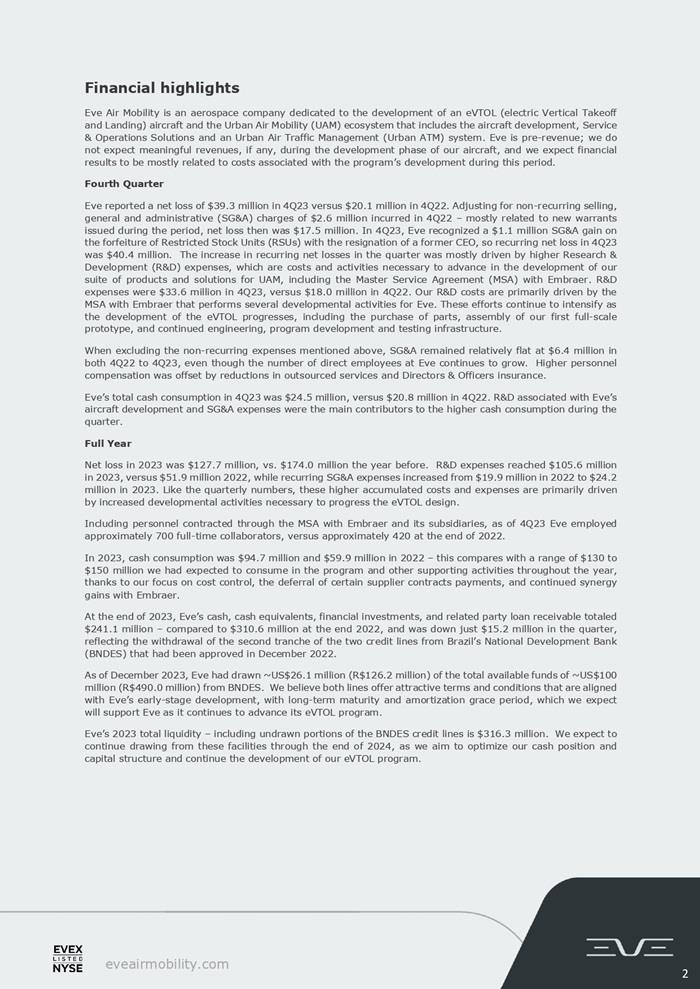
eVTOL development program with the selection of all flight-critical component suppliers, defining the final architecture and commencing the assembly of our first full-scale eVTOL prototype. Additionally, we secured Service & Operations Solutions contracts with customers that improve our revenue visibility as we enter into service aided by the Embraer heritage and global network. Lastly, we continue to advance on our Urban Air Traffic Management (UATM) solution and executed a 4-day simulation of our system in London to further refine our software and solution to scale UAM globally and safely. With funding secured through 2025, Eve will continue to accelerate program development with ambitious targets for 2024 and 2025: • Selection of eVTOL suppliers mostly concluded Following the selection of suppliers of flight-critical components – electric motors, energy management systems, propellers, thermal management systems, actuators, sensors, avionics, pilot controls, etc., Eve is finalizing the supplier’s selection with upcoming announcements on electrical distribution system, currency converters, skids and landing gear, cabin interior and doors, lighting, transparencies, among others. • Definition of Certification Basis and Means of Compliance The certification basis definition is progressing with ANAC, Eve's primary certification authority, which recently published the proposed basis for public commenting. This step follows the application for type certification in 2022 and is standard process for developing new certification bases. It promotes a harmonization of the basis with those of other manufacturers and certification authorities, an important milestone in the project, and is expected to be followed by the final publication still in 2024. • Conclude first prototype assembly / initiate test campaign The certification basis definition is progressing with ANAC, Eve's primary certification authority, which recently published the proposed basis for public commenting. This step follows the application for type certification in 2022 ans is standard process for developing new certification bases. It promotes a harmonization of the basis with those of other manufacturers and certification authorities, an important milestone in the project, and is expected to be followed by the final publication still in 2024. Key Financial Indicators Upcoming milestones During 2023, Eve focused on solidifying our eVTOL development program with the selection of all flight-critical component suppliers, defining the final architecture and commencing the assembly of our first full-scale eVTOL prototype. Additionally, we secured Service & Operations Solutions contracts with customers that improve our revenue visibility as we enter into service aided by the Embraer heritage and global network. Lastly, we continue to advance on our Urban Air Traffic Management (UATM) solution and executed a 4-day simulation of our system in London to further refine our software and solution to scale UAM globally and safely. With funding secured through 2025, Eve will continue to accelerate program development with ambitious targets for 2024 and 2025: • Selection of eVTOL suppliers mostly concluded Following the selection of suppliers of flight-critical components – electric motors, energy management systems, propellers, thermal management systems, actuators, sensors, avionics, pilot controls, etc., Eve is finalizing the supplier’s selection with upcoming announcements on electrical distribution system, currency converters, skids and landing gear, cabin interior and doors, lighting, transparencies, among others. • Definition of Certification Basis and Means of Compliance The certification basis definition is progressing with ANAC, Eve's primary certification authority, which recently published the proposed basis for public commenting. This step follows the application for type certification in 2022 and is standard process for developing new certification bases. It promotes a harmonization of the basis with those of other manufacturers and certification authorities, an important milestone in the project, and is expected to be followed by the final publication still in 2024. • Conclude first prototype assembly / initiate test campaign The certification basis definition is progressing with ANAC, Eve's primary certification authority, which recently published the proposed basis for public commenting. This step follows the application for type certification in 2022 ans is standard process for developing new certification bases. It promotes a harmonization of the basis with those of other manufacturers and certification authorities, an important milestone in the project, and is expected to be followed by the final publication still in 2024.
We had previously received the necessary tooling and carbon laminates to be used in the manufacturing process of the composite wing. It is now nearly complete with harness – a complex system of wires and electrical cables that is used to connect electrical and electronic components to flight surfaces and sensors with necessary redundancies in the system for safety as well as internal structures. Next, we plan to install, still in March the control surfaces – ailerons and rudder, and the electric actuators to move them and direct the eVTOL mid-flight. Internally, the wing is made up of ribs – the “skeleton” that gives it a lightweight and robust structure and its aerodynamic shape, and spars – attachments to the fuselage. These are designed to be strong and flexible and support the weight of the aircraft safely considering the inherent in-flight stresses they will experience. Separately, we are assembling the empennage. It too is made up of composite materials – for a lightweight and reliable structure, with its own harness, spars and ribs. The empennage will house the dual in-line electric motor for the pusher – this will be used in the cruise phases of the flight and be powered by a carbon-fiber propeller in a five-blade configuration. All the aircraft propellers – for the pusher and eight rotors, were designed to maximize the thrust / energy requirement equation, while also reducing sound emission. We have thoroughly tested several different propeller configurations with varying shapes, angles of attack and areas in our CFD models as well as in custom-built motor-propeller rigs to achieve optimal efficiency of our current design. And, unlike the propeller in the pusher for horizontal flight, the rotor propellers will have two blades. To reduce aerodynamic drag during the cruise flight, they will face forward and rest perpendicular to the wing once the aircraft has enough lift in the wing for airplane-like flight. Lastly, we have positioned the wing and empennage on the fuselage– shown in the left. The picture also shows the future placement of the four pylons – in red marking on the ground, the structures that house the motors and connect them to the wing. Each pylon will have an electric propulsion system at the front and one at the rear. We plan on installing the composite “skin” of the eVTOL, later in the assembly process, and once all the internal work is complete. The aircraft will have similar dimensions to popular helicopters that also have a capacity for four passengers. With a wingspan of 50ft (15.2m), 11ft (3.3m) cabin length, it was designed to fit in most of the currently available helipads.
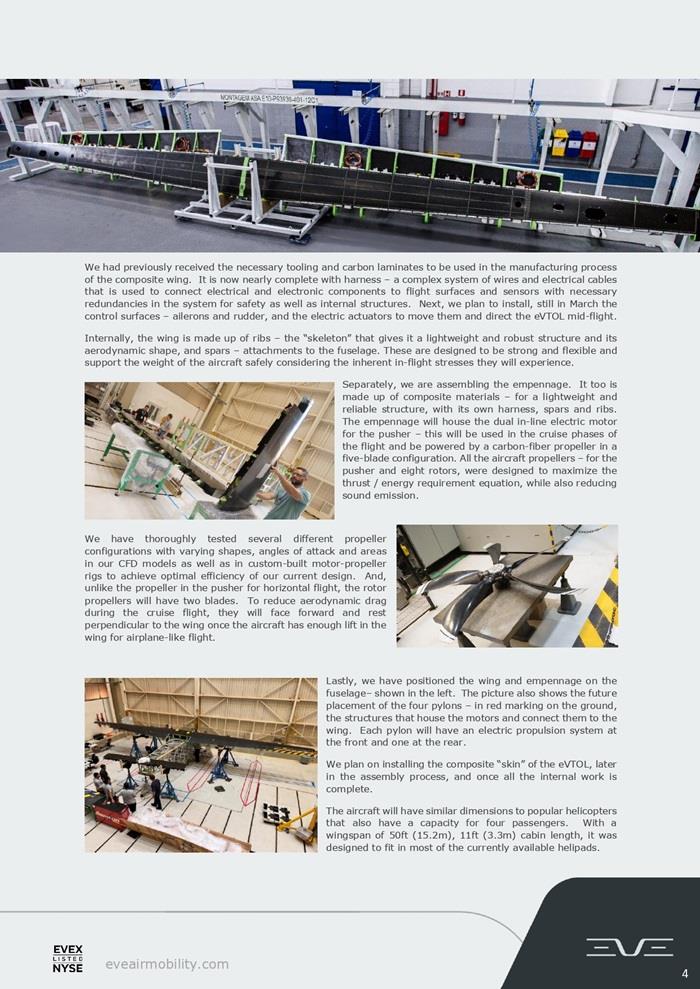
eVTOL factory Earlier in the year, we selected a former Embraer site in the city of Taubaté, São Paulo - Brazil, to house our first production site, with total capacity of 480 units / year. We intend to start preparing the facility to accommodate our initial production efforts in 2024. This will require specialized tooling and equipment, some civil construction and upgrade of facilities for aircraft and equipment tests. We will implement a modular manufacturing approach – with four equally-sized modules to maximize the efficiency of our capital deployed in the site. • Total cash consumption With intensifying program development efforts, continued supplier selection, assembly of our prototypes, and necessary investments in the production site, Eve expects a total cash consumption between $130 and $170 million in 2024. This compares to $59.9 million invested in the program in 2022 and $94.7 million in 2023. The additional program activities will require an increase in the number of engineering hours – via our MSA with Embraer as well as direct Eve personnel, and the acquisition of raw materials and parts/components for our prototypes. Additionally, we will increase engagement with selected suppliers and receive equipment during the remainder of 2024, which will trigger additional cash consumption in the coming months. While we continue to expect sequentially higher investments and expenses in the quarters ahead due to intensifying engineering engagement as well as potential supplier payments, we are confident that our current liquidity is sufficient to fund our operations, design and certification efforts through 2025. We had previously received the necessary tooling and carbon laminates to be used in the manufacturing process of the composite wing. It is now nearly complete with harness – a complex system of wires and electrical cables that is used to connect electrical and electronic components to flight surfaces and sensors with necessary redundancies in the system for safety as well as internal structures. Next, we plan to install, still in March the control surfaces – ailerons and rudder, and the electric actuators to move them and direct the eVTOL mid-flight. Internally, the wing is made up of ribs – the “skeleton” that gives it a lightweight and robust structure and its aerodynamic shape, and spars – attachments to the fuselage. These are designed to be strong and flexible and support the weight of the aircraft safely considering the inherent in-flight stresses they will experience. Separately, we are assembling the empennage. It too is made up of composite materials – for a lightweight and reliable structure, with its own harness, spars and ribs. The empennage will house the dual in-line electric motor for the pusher – this will be used in the cruise phases of the flight and be powered by a carbon-fiber propeller in a five-blade configuration. All the aircraft propellers – for the pusher and eight rotors, were designed to maximize the thrust / energy requirement equation, while also reducing sound emission. We have thoroughly tested several different propeller configurations with varying shapes, angles of attack and areas in our CFD models as well as in custom-built motor-propeller rigs to achieve optimal efficiency of our current design. And, unlike the propeller in the pusher for horizontal flight, the rotor propellers will have two blades. To reduce aerodynamic drag during the cruise flight, they will face forward and rest perpendicular to the wing once the aircraft has enough lift in the wing for airplane-like flight. Lastly, we have positioned the wing and empennage on the fuselage– shown in the left. The picture also shows the future placement of the four pylons – in red marking on the ground, the structures that house the motors and connect them to the wing. Each pylon will have an electric propulsion system at the front and one at the rear. We plan on installing the composite “skin” of the eVTOL, later in the assembly process, and once all the internal work is complete. The aircraft will have similar dimensions to popular helicopters that also have a capacity for four passengers. With a wingspan of 50ft (15.2m), 11ft (3.3m) cabin length, it was designed to fit in most of the currently available helipads.
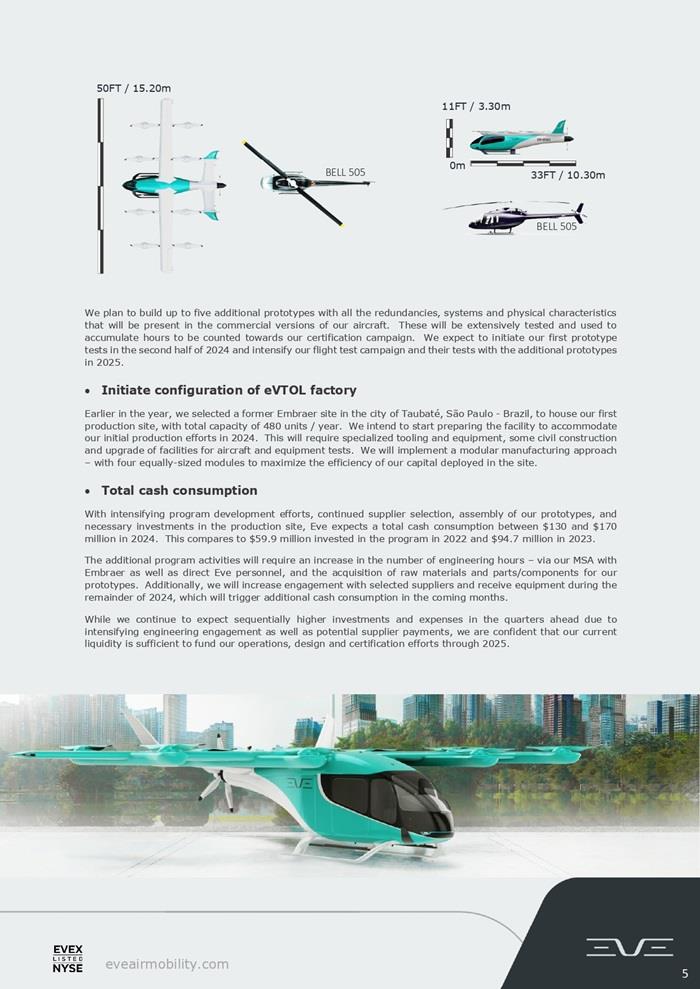
Eve named suppliers for sensors, guidance and navigation, seats, flight controls, wings and pilot controls On January 29, 2024, Eve announced four additional suppliers for its eVTOL: Honeywell will supply guidance and navigation products including magnetometers, GPS-aided attitude & heading reference systems, and inertial reference systems built upon decades of engineering and manufacturing experience. These systems will relay and aid the pilots and other onboard systems to ensure safe and efficient flight. The company will also supply external lighting for the aircraft. Thales will supply a proven air data solution, comprising sensors and computers, which gather critical data such as airspeed, altitude and environmental conditions. The solution then relays the information to pilots and onboard systems to ensure safe and efficient flight in all weather conditions. RECARO Aircraft Seating, a global supplier of premium aircraft seats for airlines, OEMs and eVTOL aircraft, was selected to design, certify and produce the four passenger seats and one pilot seat for the aircraft. RECARO is widely recognized for product innovation, award-winning customer service and commitment to reliability, efficiency and sustainable practices. FACC was selected to lead the development and production of the eVTOL’s horizontal and vertical tail including its rudder, elevator and the aircraft’s aileron. FACC is recognized for its production of lightweight components relying on innovative manufacturing techniques and technology. Later, on February 20, 2024, Eve named two additional suppliers for its eVTOL aircraft: Aciturri will be responsible for the development and manufacturing of the wing skins and spars as well as the leading and trailing edges of the wing. Aciturri has a wealth of experience in developing aerostructures for multiple types of aircraft. Specifically, the company’s experience and expertise in engineering and sustainably manufacturing aerostructures for the Urban Air Mobility segment led to their selection to produce the wing for Eve’s eVTOL. Aciturri is a founding member of Clean Aviation – the benchmark public-private initiative in the EU for the development of new aeronautical technologies. Crouzet will manufacture and supply the pilot controls, specifically the inceptor, for Eve’s eVTOL. The company has more than a century of manufacturing expertise and is recognized for producing high-quality mechatronic components for numerous industries including Aerospace, Transportation and Industry. The eVTOL’s inceptor will be ergonomically designed to ensure pilot comfort and provide immediate response to pilot inputs. Both Aciturri and Crouzet have signed agreements that cover the aircraft’s life cycle including prototype production and aftermarket service and operational support. eVTOL: Honeywell will supply guidance and navigation products including magnetometers, GPS-aided attitude & heading reference systems, and inertial reference systems built upon decades of engineering and manufacturing experience. These systems will relay and aid the pilots and other onboard systems to ensure safe and efficient flight. The company will also supply external lighting for the aircraft. Thales will supply a proven air data solution, comprising sensors and computers, which gather critical data such as airspeed, altitude and environmental conditions. The solution then relays the information to pilots and onboard systems to ensure safe and efficient flight in all weather conditions. RECARO Aircraft Seating, a global supplier of premium aircraft seats for airlines, OEMs and eVTOL aircraft, was selected to design, certify and produce the four passenger seats and one pilot seat for the aircraft. RECARO is widely recognized for product innovation, award-winning customer service and commitment to reliability, efficiency and sustainable practices. FACC was selected to lead the development and production of the eVTOL’s horizontal and vertical tail including its rudder, elevator and the aircraft’s aileron. FACC is recognized for its production of lightweight components relying on innovative manufacturing techniques and technology. Later, on February 20, 2024, Eve named two additional suppliers for its eVTOL aircraft: Aciturri will be responsible for the development and manufacturing of the wing skins and spars as well as the leading and trailing edges of the wing. Aciturri has a wealth of experience in developing aerostructures for multiple types of aircraft. Specifically, the company’s experience and expertise in engineering and sustainably manufacturing aerostructures for the Urban Air Mobility segment led to their selection to produce the wing for Eve’s eVTOL. Aciturri is a founding member of Clean Aviation – the benchmark public-private initiative in the EU for the development of new aeronautical technologies. Crouzet will manufacture and supply the pilot controls, specifically the inceptor, for Eve’s eVTOL. The company has more than a century of manufacturing expertise and is recognized for producing high-quality mechatronic components for numerous industries including Aerospace, Transportation and Industry. The eVTOL’s inceptor will be ergonomically designed to ensure pilot comfort and provide immediate response to pilot inputs. Both Aciturri and Crouzet have signed agreements that cover the aircraft’s life cycle including prototype production and aftermarket service and operational support.
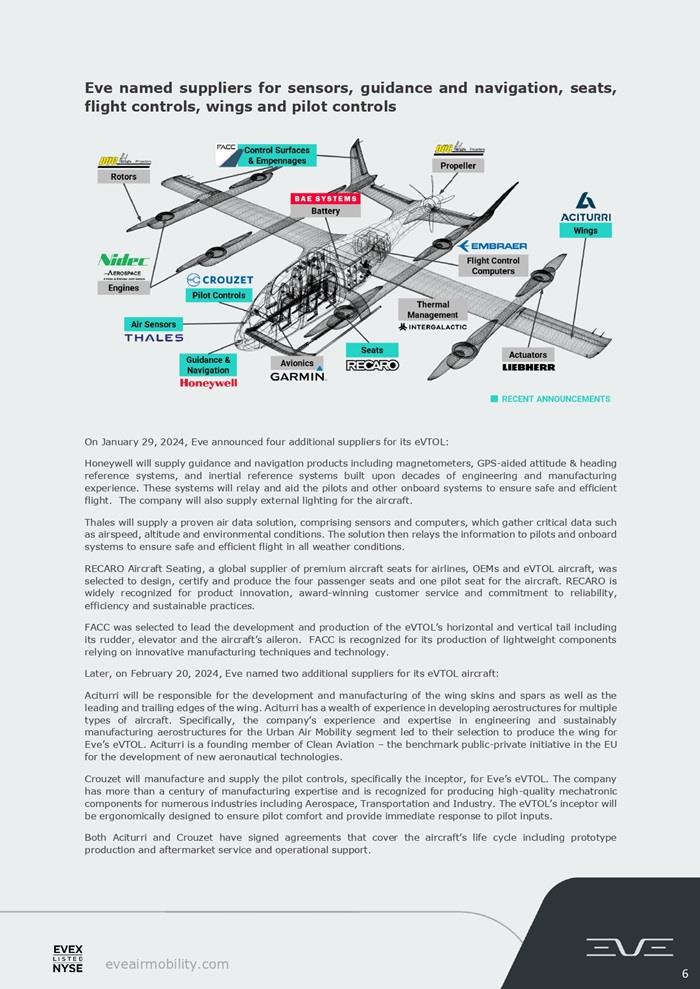
These new suppliers are in addition to Garmin, Liebherr Aerospace and Intergalactic that were announced in October and Nidec Aerospace LLC, a joint venture between Japan’s Nidec Corporation and Brazil’s Embraer, BAE Systems and DUC Hélices Propellers which were announced at the Paris Air Show last summer.
Urban Air Traffic Management (UATM) U.K. Simulation
Eve’s Urban ATM software is an agnostic solution that will enable the integration of all airspace users in the urban environment. We believe this to be critical to support the safety, efficiency, and improvement of the entire UAM ecosystem, including fleet and vertiport operators and help it scale globally.
Eve has engaged Atech, Embraer’s Air Traffic Control technology and system integrator company, to support the development of the Urban ATM software solution. Eve is leveraging Atech’s experience in developing aviation-grade products for ATM systems in Brazil.
From before take-off to after landing, the urban air environment will count on integrated systems, services and technologies being developed by Eve to support eVTOL operations alongside UATM systems and many other airspace users. In the future, the advancement of infrastructure and regulation will rely on these network management services to enable autonomous flight.
The company continues to collaborate with regulators, customers air navigation service providers, fleet operators, vertiport developers, airports and other UAM ecosystems stakeholders globally to advance concepts and develop technology to support initial operation and scaling of UAM operations from an ATM perspective.
One example of such collaboration is a successful 5-day simulation conducted in the United Kingdom with Flexjet. This test was used to validate and refine our software under real-world conditions. Our software was used in parallel to the incumbent software to simulate the functions. While not actively carrying out the functions and operations itself, the software was tested through the actual business operations, as opposed to simply prescribing a specific scenario. This tested and demonstrated the robustness of the software we have developed within the context of a real-world environment to better understand the commercial viability and applications of the product.
Our solution was deployed to track 18 separate flights flown by different aircraft across a dynamic network of 8 aerodromes. The simulation included a playbook of 26 different routes, with alternative landing locations to test standby flight plan functionality. Besides running simulations under normal conditions, our team also tested delay at departure, delay at destination – with impacts in incoming flights, delay and/or flight cancellation due to airspace/weather constraints, in-flight emergency and alternative landing location. More details on page 11 of this report.
Backlog, Order Pipeline
Services & Operations Solutions
Eve is replicating elements of Embraer’s proven business model, namely the design, manufacturing, and sale of aircraft. In addition, we will also provide MRO (Maintenance, Repair and Overhaul) services on an agnostic basis worldwide. With that, Eve is uniquely positioned to serve its customers by leveraging Embraer’s global presence with local support and has secured non-binding contracts for Services & Operations Solutions across the world with 10 customers. Combined, these customers have placed LOIs for approximately 1,000 of our eVTOLs.
These contracts include MRO, training, battery services, data integration and spare parts solutions, as well as component repair. These functions will be enhanced by a MoU (Memorandum of Understanding) signed with DHL Supply Chain to optimize supply chain to service centers. The MoU will also focus on batteries and the specific requirements for transporting, storing, and disposing of those devices.
These non-binding Service & Operations Solutions contracts are estimated to bring potential revenues of $660 million during the first five years of the vehicle operation and because of our agnostic approach to the maintenance business, Service & Operations Support revenues could precede the first delivery of our eVTOL.
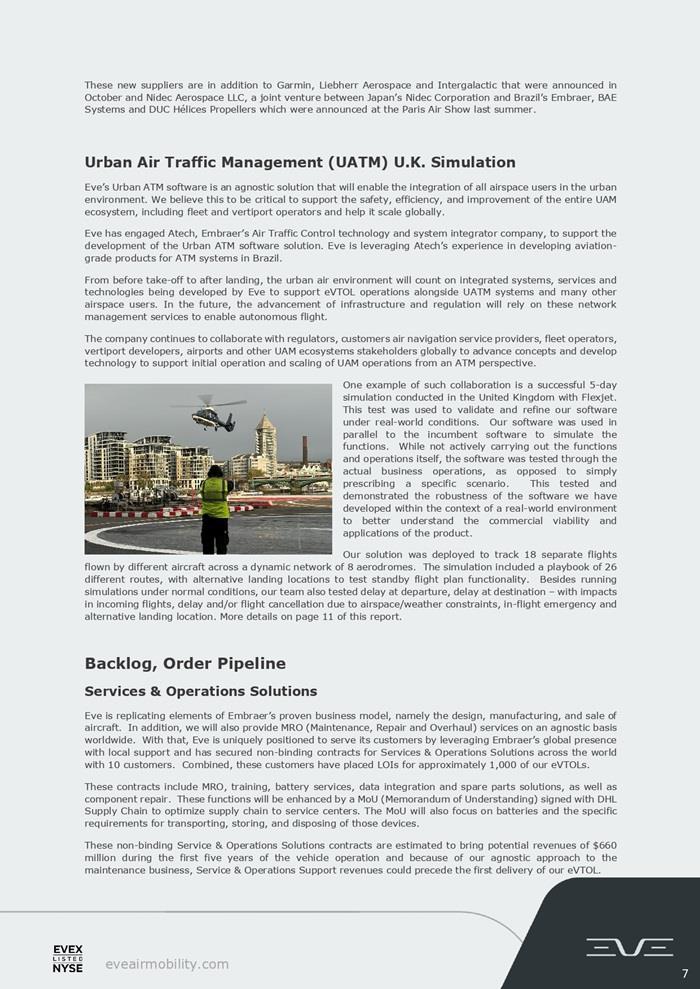
Lastly, and in addition to eVTOL sales and Service and Operations solutions, Eve is also engaged in developing software for Urban Air Traffic Management (Urban ATM) and has signed Letters of Intent (LOIs) from 14 customers globally. eVTOL Orders Currently, Eve’s order pipeline totals 2,850 units with a total non-binding backlog value of approximately $8.6 billion. Our initial order pipeline is based on non-binding LOIs and therefore subject to change, consistent with common aviation practices. Eve’s current client base is comprised of 29 customers, with no client representing more than 14% of the total order book, including options. The order book is further diversified by the industries in which these customers operate, with airlines representing 40%, helicopter operators 25%, ride-sharing platforms 14%, and lessors 15%. Lastly, Eve has received LOIs from clients in 13 different countries spread over five continents across the globe. The Americas is home to close to two thirds of Eve’s backlog (North America is 44% and South America 17%), while Europe represents 19% of the LOIs, and Asia 9%. Rather than relying on traditional combustion engines, eVTOL aircraft are designed to use electric motors, providing an alternative means of transportation in urban markets that do not produce carbon emissions. Eve’s design uses a conventional fixed wing and empennage, rotors and a pusher, giving it a practical and intuitive lift-plus-cruise design, which favors safety, efficiency, reliability and certifiability, while being environmentally friendly at the same time. With an expected range of 60 miles (approx. 100 kilometers), Eve’s aircraft have the potential to not only offer a sustainable and affordable commute, but also to reduce sound levels compared to current conventional helicopters. Its human-centered design ensures the comfort of passengers, the pilot and the community by minimizing sound. The all-electric aircraft features dedicated rotors for vertical flight and a fixed wing to fly on cruise, with no components required to change position during flight. It will be piloted at launch but evolving towards uncrewed operations in the future.
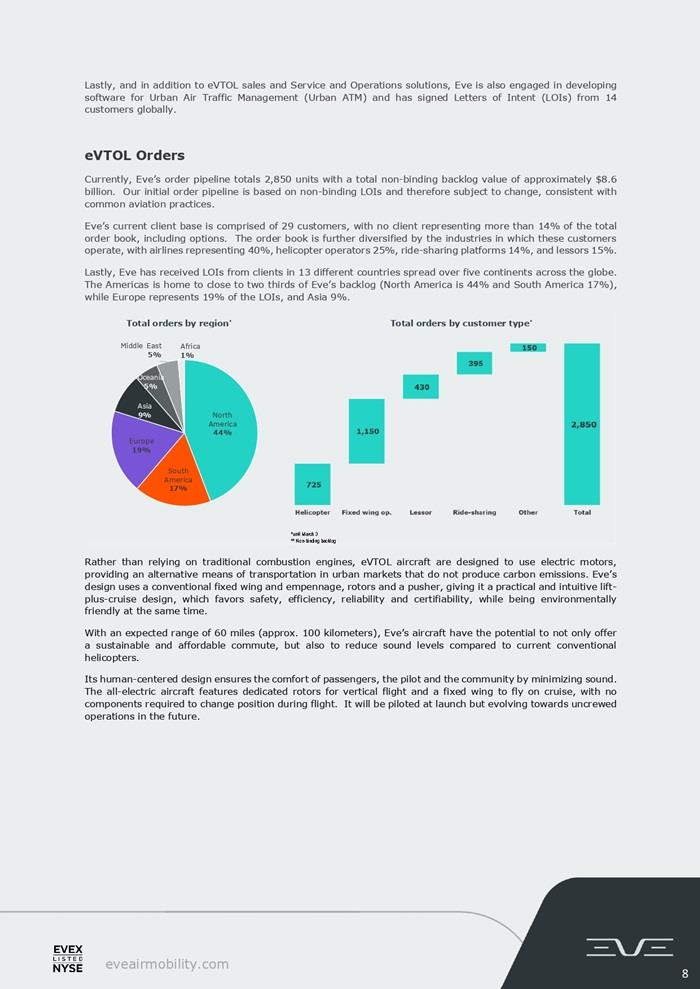
Latest Highlights Eve and Kookiejar to develop UATM system for operations in Dubai On November 13, Eve and Kookiejar, a Swedish-based vertiport developer, signed a letter of intent (LOI) for Eve’s Urban ATM (Air Traffic Management) system to support vertiport operations in Dubai. The agreement marks Eve’s first Urban ATM agreement in Dubai and Kookiejar becomes the company’s 10th Urban ATM customer and fifth vertiport customer as the company continues to grow its global customer base. The agreement comes as Kookiejar, along with its local partner Air Chateau, is preparing to showcase Dubai’s first state of the art vertiport hub facility with eight parking pads and a FATO at Al Maktoum Airport, Dubai South. Eve’s Urban ATM product has been adopted as part of Kookiejar and Air Chateau’s grand vision for Dubai. The vision is a phased implementation program in which networks of vertiports will be connected via Eve’s Urban ATM system to support a safe and scaled Urban Air Mobility (UAM) operations that provides a path to commercialization in 2025-2026. Kookiejar is already working with stakeholders in Dubai to carefully think about the routes that eVTOLs will take within existing VFR corridors that helicopters use today with its partners Vertiport Hub at Air Chateau and Dubai South. The goal is to have eVTOLs operate seamlessly with existing commercial air traffic management systems and the UATM systems. This strategic agreement will bolster Dubai’s position in the Advanced Air Mobility (AAM) industry by capitalizing on the synergies between Eve and Kookiejar. Eve and Hunch Mobility to bring eVTOL flights to Bangalore On November 14, Eve and Hunch Mobility, a joint venture between Hunch Ventures and Blade Air Mobility, announced that the two companies are working together to bring first electric commuter flights to Bangalore, India. With the announcement, Bangalore becomes the launch city in the region for urban air mobility flights utilizing electric vertical takeoff and landing (eVTOL) aircraft. The announcement is the first step as both companies will be working with local, state and federal officials, infrastructure, energy and technology providers. The goal is to ensure the appropriate infrastructure is in place to introduce eVTOL aircraft flights. Bangalore, located in Karnataka state of India, is one of the most populated cities in the world with an estimated population of more than 13 million people. The emergence of electric aviation with eVTOL vehicles is expected to significantly reduce the carbon footprint, noise and cost of flying, making it more accessible to the masses. Eve’s eVTOL will offer Hunch Mobility’s customers a quick and economical way to avoid traffic congestion in one of the world’s most dense urban environments. Eve’s eVTOL is 100% electric and has a range of 100 kilometers (60 miles) allowing it to complete a variety of urban air mobility missions in Bangalore. Eve was the first eVTOL manufacturer to announce an LOI in India with Hunch Mobility announcing an agreement to purchase 200 eVTOLs, Services and the company’s Urban ATM (Air Traffic Management) solution. As part of the LOI announcement, Eve and Hunch embarked on a three-month-long pilot project, conducting intra-city helicopter flights in Bangalore. The objective was to collect data on operations and customer experiences
throughout the pilot project. This data, in turn, is informing the further development of Eve's eVTOL aircraft, its air traffic management solution, and solutions for service and support. In addition to a new, efficient transportation option, Eve and Hunch Mobility noted that eVTOL flights in the Bangalore are expected to have a positive economic impact on the community including new employment opportunities. Positions ranging from pilots and aircraft service technicians to training and technical services are among the numerous roles that will be needed as eVTOL flights are introduced and expand. The development of the necessary infrastructure to support eVTOL operations is also expected to contribute value and employment opportunities to the community. Eve and NATS announced collaboration to develop UATM Services Also on November 14, Eve and NATS Services, the commercial arm of the UK’s leading provider of air traffic control services, announced at the Dubai Airshow a collaborative effort supporting the development of future traffic management services for UAM operators around the world. The signed Memorandum of Understanding (MoU) reinforces the partnership between the two companies to make UAM a safe reality and will advance technologies for a faster, more efficient and sustainable urban air transportation system for all. The Eve-led UK Concept of Operations (CONOPS) was developed in partnership with the UK Civil Aviation Authority (UK CAA) and global companies, including NATS as well as six other members, and leveraged data to focus on necessary solutions for near-term UAM concerns for London. The UK CAA published the Phase 1 results of the Future Air Mobility Regulatory Sandbox project in October 2021, highlighting eVTOL strengths and the challenges that will inform future developments in the UAM industry. Eve and NATS have also been part of the Future Flight Challenge through the Advanced Mobility Ecosystem Consortium with leading British aviation companies since July 2022. Developed by UK Research and Innovation and delivered by Innovate UK, the program is UK Government funded and aims to accelerate the progress of new technologies and advanced aviation solutions while showcasing the societal benefits of aviation’s progress. Eve and Jeju Air Released ConOps for UAM in South Korea On November 28, Eve and Jeju Air, the first and largest South Korean low-cost airline, announced the release of a new concept of operations white paper for electric vertical take-off and landing (eVTOL) flights on Jeju Island. The two companies collaborated to produce the analysis which is the first step in understanding what will be needed to make future urban air mobility (UAM) operations in South Korea a reality. The jointly written white paper examines in detail, the operational and commercial business case of establishing UAM services in Jeju Island. This includes analysis and findings from the Jejuair voice of customer survey done earlier in 2023. South Korea is one of the first countries to begin laying the groundwork for urban air mobility. Establishing a concept of operations is one of the first steps toward future Urban Air Mobility. Eve has worked with a variety of cities, countries and regulatory authorities to establish concepts of operations in the U.S., Brazil, U.K. and others around the world. The CONOPS is available on Eve’s website for the entire community to better understand how the UAM ecosystem will enable a new means of affordable, safe and sustainable transportation on Jeju Island. Eve hopes that the CONOPS will encourage all those responsible for this ecosystem to evolve together so that the industry, regulatory
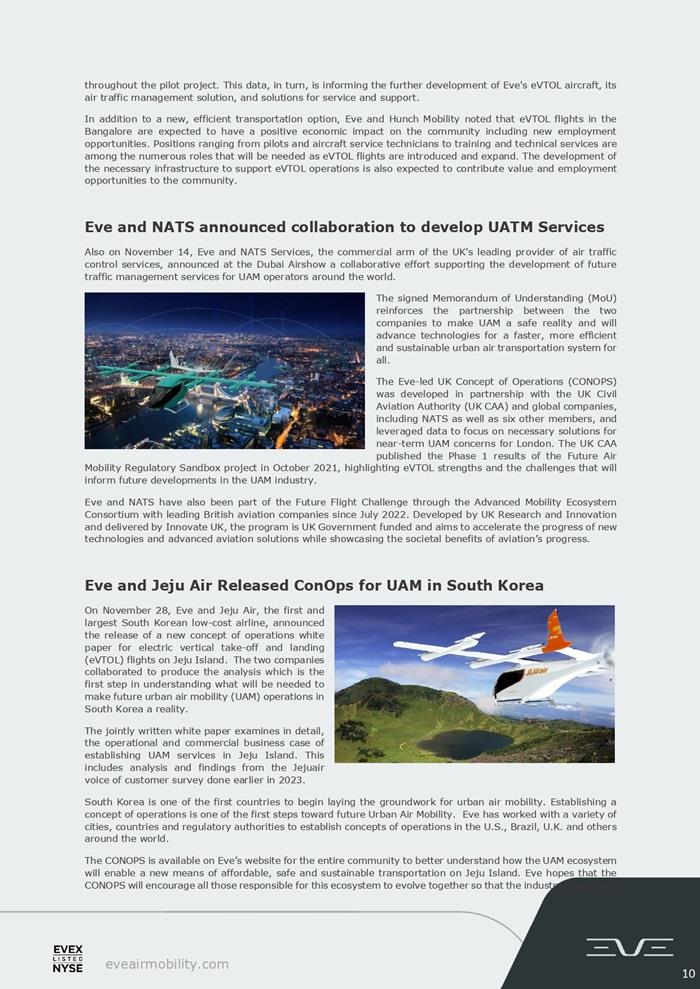
agencies, civil and government entities, and the community can continue investing in, developing, and integrating this new mode of transportation. Eve and flynas sign MoU to propel eVTOL advancements in Saudi Arabia On November 29, Eve and flynas, the leading low-cost airline in the world and the Middle East, announced the signature of a Memorandum of Understanding (MoU) to explore the future of eVTOL aircraft operations in Saudi Arabia. The partners will explore the possibility of starting eVTOL operations in Riyadh and Jeddah in 2026. The agreement will contribute to Saudi Arabia’s aviation industry by building and supporting the future local ecosystem for electric flights. The partnership will also contribute to the Vision 2030 sustainability goals and the ambitious targets in the aviation sector. This collaborative effort between Eve and flynas and the introduction of eVTOL flights to Saudi Arabia will provide travelers with another option for urban transportation while affirming the companies’ commitment to shaping the future of electric aviation and delivering efficient, safe and sustainable transportation to the region. Eve collaborates with Flexjet to advance UAM through innovative software simulation On November 30, Eve achieved a key milestone in the progression of Urban Air Mobility (UAM) through a collaborative partnership with global private aviation leader Flexjet. Together, the companies have conducted an initial software simulation of Eve’s cutting-edge Urban Air Traffic Management (Urban ATM) solution. The initiative validated and refined the software through user testing and feedback on its interface and industry value. With London being one of the world’s foremost helicopter markets and a key focus for future eVTOL operations, the simulation took place over four days at Flexjet’s Tactical Control Centre at Farnborough Airport, UK, and saw Eve’s Urban ATM software shadowing live helicopter flights operated by Flexjet’s UK helicopter division, performing the kind of services that will be essential to enabling future UAM operations. Flexjet operates a fleet of 11 helicopters in the UK and its group of companies is one of Eve’s Urban ATM Fleet Operator customers. Leading UK helicopter operator Flexjet provided its helicopter fleet to perform flights, collaborating closely with Eve’s Urban ATM team. NATS, the UK’s leading provider of air traffic control services, and London Heliport supported the initiative by providing additional feedback to help ensure Eve’s solution will provide the greatest value to all UAM ecosystem participants. The initiative encompassed various aspects of operations, including regular business operations, atypical scenarios and flights tailored to an eVTOL aircraft’s specific needs, enabling the demonstration of product behavior in various real-world scenarios. The integration of vertiports to efficiently manage resources was the primary focus of the test, in addition to verifying and validating a subset of the Urban ATM product capabilities, with a specific emphasis on the UAM fleet operator support tool. Eve’s objective with this collaboration was to provide insights into the services required to support future eVTOL operations safely and efficiently. Another aim was to investigate whether these new services may have immediate value for existing helicopter operations. Following the simulation, Eve and Flexjet reviewed the findings and discussed recommendations for improvements, changes, and potential integration requirements. The companies will also continue to explore opportunities for further integration of existing software tools, enhancing the potential of the Urban ATM solution.
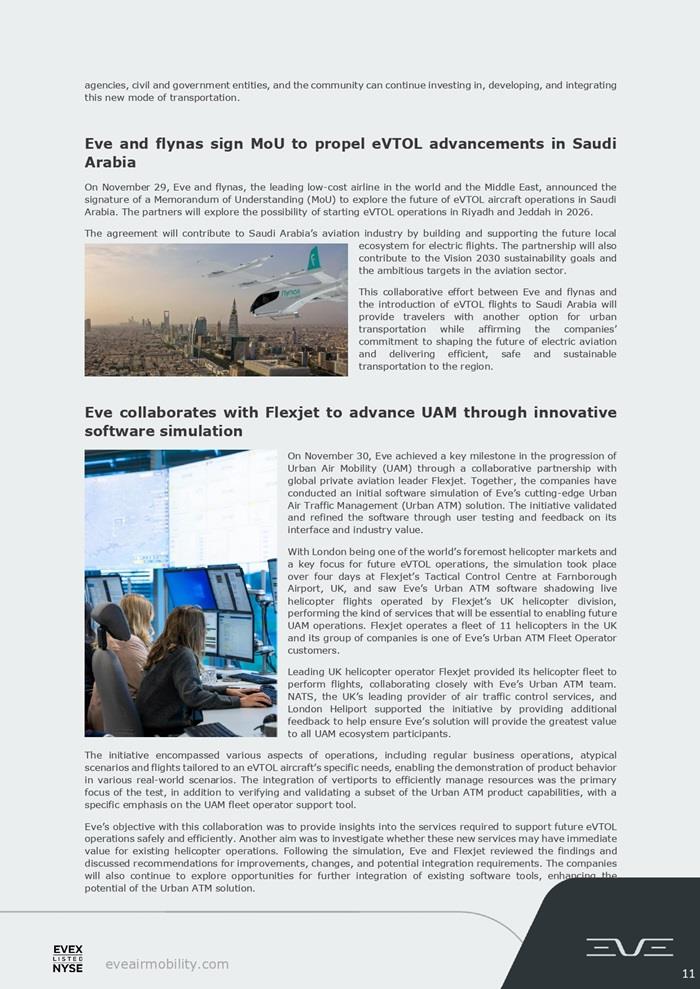
Electric UAM has the capability to improve the affordability of urban flights for communities, compared to current helicopter operations, and features a streamlined and efficient design, which contributes to reduced operational and maintenance costs. Eve’s Urban ATM solutions will support this by maximizing the utilization of aircraft and vertiports, further reducing operational costs. This innovative collaboration between Eve and Flexjet is a testament to their commitment to shaping the future of urban air mobility and providing efficient and sustainable solutions for the future of urban transportation. Eve Air Mobility hosted Customer Advisory Board On December 18, Eve held its Customer Advisory Board meeting at its headquarters in Melbourne, Fla. Customers and partners from 12 companies and nearly every continent came together to discuss the aircraft, operations, ecosystem readiness and services and solutions. Eve’s Customer Advisory Board comprises a wide variety of operators including fixed-wing and rotorcraft operators and lessors, all with the objective of co-creating the Urban Air Mobility (UAM) ecosystem. The discussions included optional items and vehicle configuration and passenger cabin experience. In addition, attendees also received a program and product update from Eve´s leadership. Eve also took the opportunity to highlight its worldwide sales and support network which includes a broad customer support infrastructure. Eve’s customers will also benefit from Embraer’s global service and support network which includes 10 existing services centers and 66 third-party service centers around the world.

Financial Performance Income Statement (Unaudited, US dollars,’000s, except where noted) Balance Sheet (Unaudited, US dollars,’000s, except where noted)

Cash Flow Statement (Unaudited, US dollars,’000s, except where noted) Webcast Details Management will discuss the results on a conference call on March 8, 2024 at 8:00 a.m. (Eastern Time). The webcast will be publicly available in the Upcoming Events section of the company website (www.eveairmobility.com). To listen by phone, please dial 1-877-704-4453 or 1-201-389-0920. A replay of the call will be available until March 22, 2024, by dialing 1-844-512-2921 or 1-412-317-6671 and entering passcode 13744291.
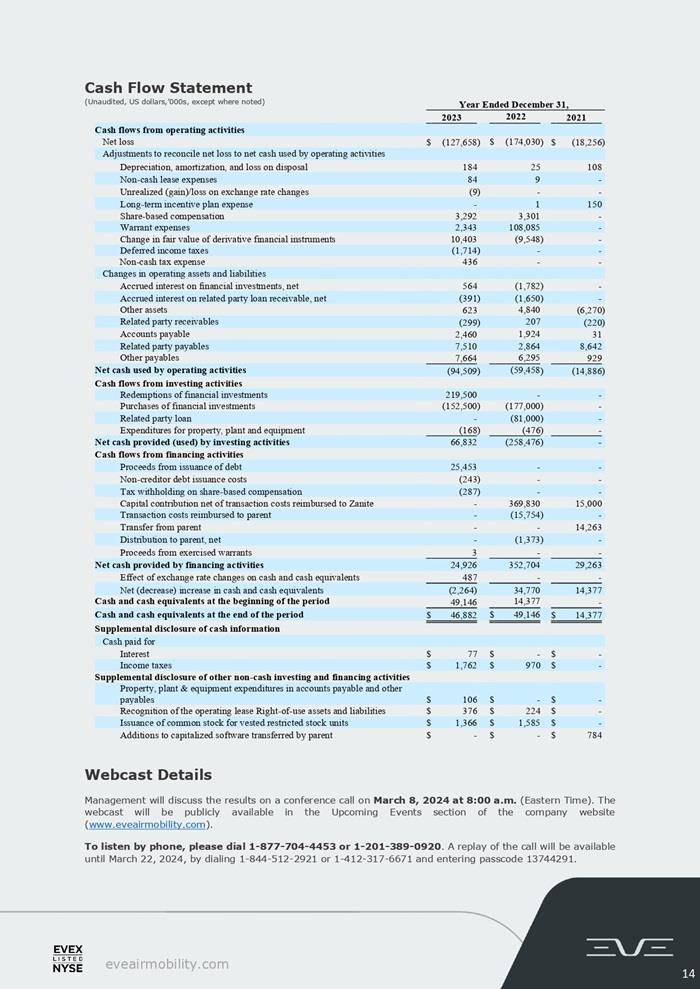
Upcoming Events Eve senior management is scheduled to attend the following investor events: Bradesco BBI 10th Brazil Investment Forum – São Paulo, SP – Brazil (Apr. 2-3, 2024) Farnborough Air Show– Farnborough, U.K. (July 22-26) Glossary of Commonly-Used Terms ACMI – Aircraft, Crew, Maintenance and Insurance AL – Airworthiness Limitations AMP – Aircraft Maintenance Program ANAC – Agência de Aviação Civil ATC – Air Traffic Control ATM – Air Traffic Management Capex – Capital expenditures for the development of expansion of the telecommunications infrastructure COGS – Cost of Goods Sold ConOps – Concept of Operations CPA – Capacity Purchase Agreements DMC – Direct Maintenance Cost EASA – European Union Aviation Safety Agency EIS – Environment Impact Statement / Entry Into Service Embraer – A global aerospace company headquartered in Brazil, Embraer has businesses in Commercial and Executive aviation, Defense & Security and Agricultural Aviation. The company designs, develops, manufactures and markets aircraft and systems, providing Services & Support to customers after-sales. Embraer is the leading manufacturer of commercial jets up to 150 seats and the main exporter of high value-added goods in Brazil. The company maintains industrial units, offices, service and parts distribution centers, among other activities, across the Americas, Africa, Asia and Europe. Embraer holds 238,5million Eve shares, or 87% of our equity. eVTOL – electric Vertical Take Off and Landing aircraft FAA – Federal Aviation Agency GAMA – General Aviation Manufacturers Association IMC – Instrument Meteorological Condition LOI – Letter of Intent for new aircraft orders and/or business partnership MEL – Minimum Equipment List MOU – Memorandum of Understanding MPP – Master Phase Plan MRB – Maintenance Review Board MRO – Maintenance, Repair and Operations MSA – Master Service Agreement OEM – Original Equipment Manufacturer PBH – Pay-by-the-hour contracts PDP – Progressive Down Payment POC – Proof of Concept PSA – Product Support Agreements QMS – Quality Management System Research and Development (R&D) – Accrued expenses related to the development of technologies of our eVTOL aircraft and UATM solutions S&S MPP – Service and Support Master Phase Plan SoS – System of Systems SoSE – System-of-Systems Engineering SVO – Simplified Vehicle operation T&M – Time and Materials contracts TRL – Technology Readiness Level UAM – Urban Air Mobility UAS – Unmanned Aircraft Systems UATM – Urban Air Traffic Management
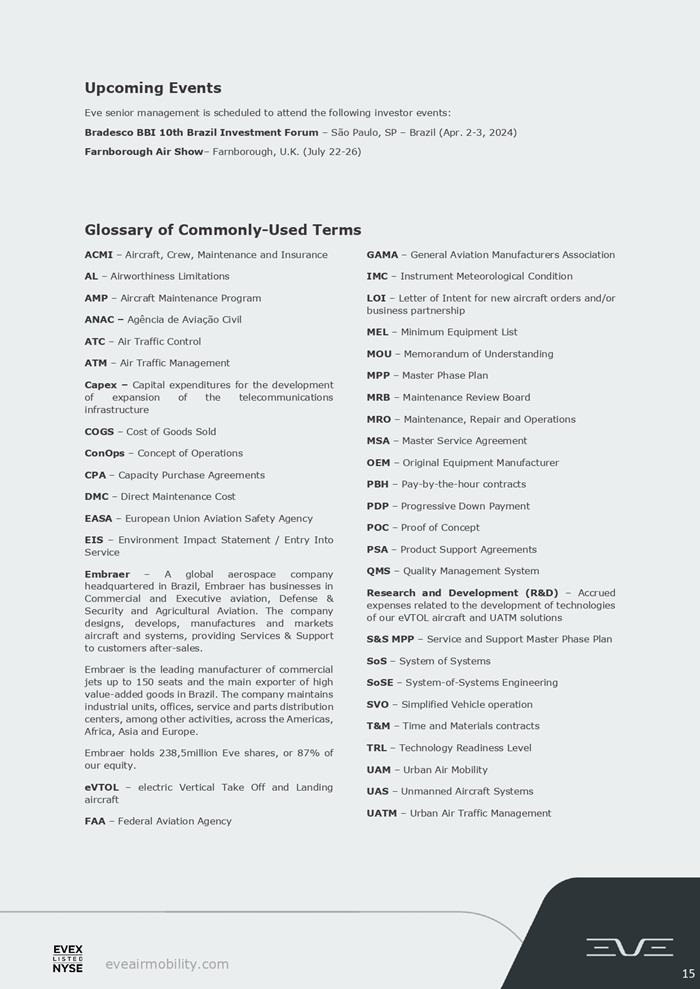
About Eve Holding, Inc. Eve is dedicated to accelerating the Urban Air Mobility ecosystem. Benefitting from a start-up mindset, backed by Embraer S.A.’s more than 50-year history of aerospace expertise, and with a singular focus, Eve is taking a holistic approach to progressing the UAM ecosystem, with an advanced eVTOL project, comprehensive global services and support network and a unique air traffic management solution. Since May 10, 2022, Eve is listed on the New York Stock Exchange, where its shares of common stock and public warrants trade under the tickers “EVEX” and “EVEXW”. Forward Looking Statements Certain statements contained in this release are forward-looking statements within the meaning of the Private Securities Litigation Reform Act of 1995. These forward-looking statements may be identified by words such as “may,” “will,” “expect,” “intend,” “anticipate,” “believe,” “estimate,” “plan,” “project,” “could,” “should,” “would,” “continue,” “seek,” “target,” “guidance,” “outlook,” “if current trends continue,” “optimistic,” “forecast” and other similar words or expressions. All statements, other than statements of historical facts, are forward-looking statements, including, but not limited to, statements about the company’s plans, objectives, expectations, outlooks, projections, intentions, estimates, and other statements of future events or conditions, including with respect to all companies or entities named within. These forward-looking statements are based on the company’s current objectives, beliefs and expectations, and they are subject to significant risks and uncertainties that may cause actual results and financial position and timing of certain events to differ materially from the information in the forward-looking statements. These risks and uncertainties include, but are not limited to, those set forth herein as well as in Part I, Item 1A. Risk Factors and Part II, Item 7. Management’s Discussion and Analysis of Financial Condition and Results of Operations of the company’s most recent Annual Report on Form 10-K, Part I, Item 2. Management’s Discussion and Analysis of Financial Condition and Results of Operations and Part II, Item 1A. Risk Factors of the company’s most recent Quarterly Report on Form 10-Q, and other risks and uncertainties listed from time to time in the company’s other filings with the Securities and Exchange Commission. Additionally, there may be other factors of which the company is not currently aware that may affect matters discussed in the forward-looking statements and may also cause actual results to differ materially from those discussed. The company does not assume any obligation to publicly update or supplement any forward-looking statement to reflect actual results, changes in assumptions or changes in other factors affecting these forward-looking statements. other than as required by law. Any forward-looking statements speak only as of the date hereof or as of the dates indicated in the statement. Investor Relations: Lucio Aldworth Caio Pinez [email protected] https://ir.eveairmobility.com/ Media: [email protected]
